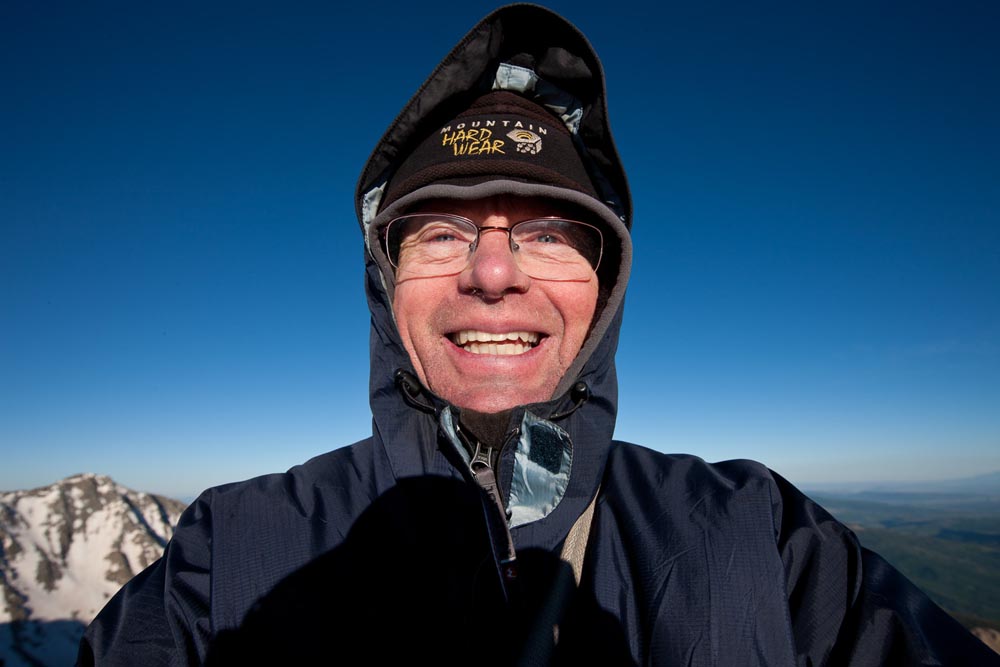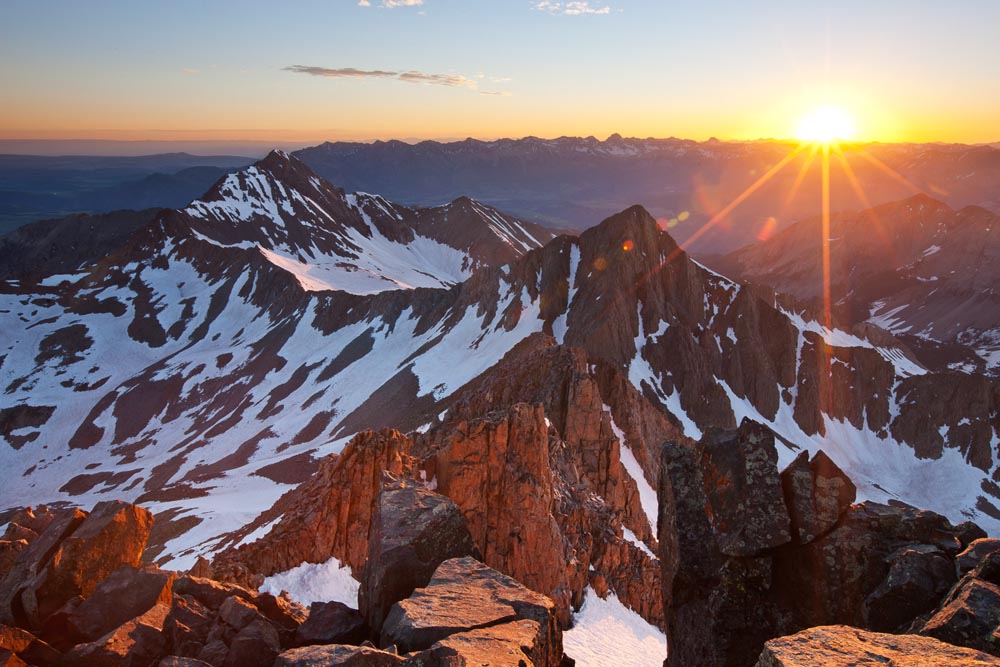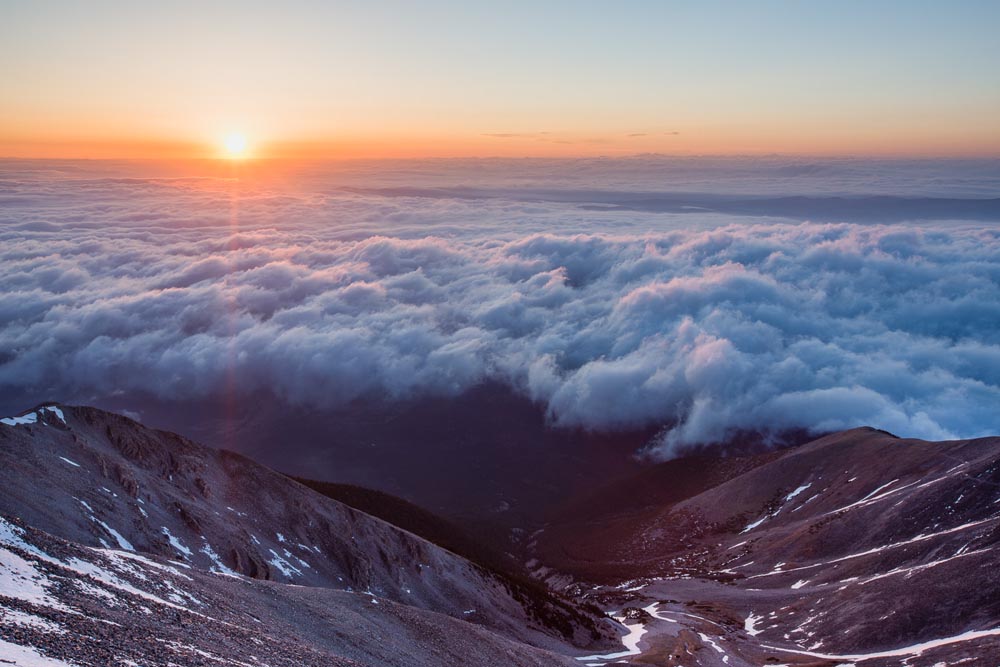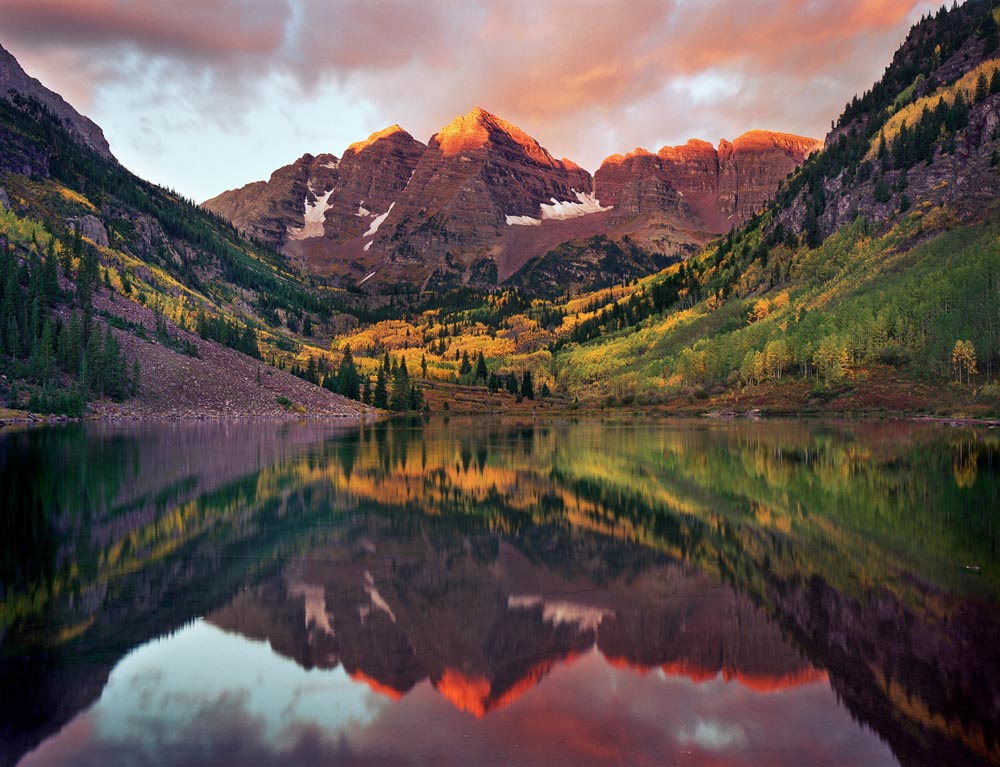
Never Eat Breakfast Before Midnight
Noted photographer John Sexton once said, “The only difference between me and my students is that I’ve made more mistakes than they have.” There’s a lot of truth in that. I have been a full-time professional landscape photographer for 26 years, so I’ve had plenty of time to learn from a long string of fumbles, failures, near-misses, and fiascos.
In this post I will share some of the lessons I’ve learned from my career in landscape photography. I’ll explain why you should never eat breakfast before midnight, why great landscape photographers have the brain of an engineer and the heart of a hopeless romantic, and why the potential reward is always greatest when the odds against you are the longest. By the time I’m finished, you’ll either be inspired to shoot sunrise from the summit of the hardest 14,000-foot peak in Colorado or be ready to sell all your cameras on eBay.

Mistakes
I want to assure you that despite the many mistakes I’ve made, I’m actually a talented, experienced, and careful photographer. In fact, I blame all of my mistakes on high-altitude hypoxia, sleep deprivation, and excessive caffeine.
Here’s an example. I was working on a seven-year project to shoot sunrise, or occasionally sunset, from the summit of all 54 of Colorado’s Fourteeners, peaks reaching over 14,000 feet in height. My next objectives were Mt. Shavano and Tabeguache Peak. Tabeguache is one of three Fourteeners in the state where the only practical route to the summit is over the summit of an adjacent Fourteener. I drove to the trailhead, hiked in, and camped at about 10,000 feet. On the same day, I got up at 10:30 p.m. and left camp 45 minutes later so I could summit Mt. Tabeguache at 4:30 a.m. and shoot sunrise.
I returned to camp, napped, then got up again at 11:30 p.m. so I could summit Mt. Shavano in time to shoot sunrise. On the way down from Mt. Shavano, still at about 14,000 feet, I stopped to photograph some tiny alpine flowers. As I was composing the shot, I discovered that auto-focus had suddenly stopped working. Repeatedly I pressed the shutter release halfway down, but the lens wouldn’t auto-focus. I checked the auto-focus switch on the lens. It was set to auto. I checked the camera body. The LCD readout confirmed that auto-focus was enabled. I switched lenses, but got the same behavior.
After puzzling over the issue for a good five minutes, I finally remembered that a year and a half earlier I had removed the auto-focus function from the shutter release and assigned it to the AF-on button on the back of the camera. For the past year and a half, I had always focused with the AF-on button on the back of the camera, not by pressing the shutter release halfway down. Just half an hour earlier, while shooting sunrise on the summit, I had been pressing the AF-on button on the back of the camera every time I wanted to focus. Granted, I was at 14,000 feet. I hadn’t slept properly in three days. Still, a photographer forgetting how to auto-focus? It was obviously long past time to get off that mountain, go home, and get some sleep.

Hard Work
This is landscape photography’s dirty little secret: it’s exciting, fun, and rewarding—and a lot of hard work. There’s just no way around this. Landscape photography requires an awful lot of getting up early and staying up late, driving hard and hiking hard. Sleep is for landscape photographers who don’t drink enough coffee. In fact, great landscape photography is one percent inspiration and 99 percent perspiration.
I reluctantly reminded myself of this inspiring phrase after I hauled my 4×5 field camera up the steep sandstone slabs to Delicate Arch for the ninth time, finally captured the longed-for glow on the arch, then heard the photographer next to me remark, “That was nice! This is the first time I’ve ever been here!”
And since we’re on the topic of hard work, here’s another of my aphorisms: the potential reward is always greatest when the odds against you are the longest. For example, the most likely outcome on a morning with heavy clouds is a gray, boring sunrise. If, however, the sun finds a tiny gap between dense clouds and the horizon, the result can be some of the most spectacular light you’ll ever be privileged to photograph.
Not only is the potential reward greatest when the odds against you are the longest: the potential reward is also greater if you remove your lens cap before taking the photo. Back in the film era, I had a medium-format Fuji rangefinder. In January, 2005, I did a solo, off-trail trip into the Sangre de Cristo Range. On the first day I hiked, then snowshoed and scrambled to a campsite at about 10,600 feet. The next day I continued upward another 1,700 vertical feet and picked out a sunset location with rippled snow in the foreground and the Fourteeners Kit Carson, Crestone Peak, and Crestone Needle in the background, all of which would get sunset light.
One disadvantage of rangefinders, of course, is that you aren’t looking through the lens, which means there’s no obvious clue that the lens cap is still on. As the light peaked, I shot two rolls of medium-format film that I thought were capturing the best light of the trip.
When I finally looked at the front of the camera and saw that the lens cap was still attached, I dropped to my knees in the snow and buried my head in my hands. Then I chided myself: Glenn, you’re alone, it’s January, you’re at 12,000 feet, it’s getting dark, and you’re 1,700 vertical feet above your campsite. This is no time to throw a hissy fit. I stood up, regrouped, and saw that the clouds over the peaks were starting to light up, so I was able to make a few decent photos even though I certainly missed the best images of the trip.

Before I became a landscape photographer, I did a lot of rock-climbing and mountaineering. On several occasions, I got up at 1 a.m. to climb a route on the Diamond, the vertical east face of 14,259-foot Longs Peak. When I started shooting landscapes seriously, I realized that if I was going to photograph sunrise light on the Diamond reflected in Chasm Lake, I was going to have to get up equally early. Sometimes the most essential piece of equipment on a landscape shoot is a really loud alarm clock.
I quickly decided that anytime I had to get up before 4 a.m. to do a shoot, I deserved two breakfasts.
During my Sunrise from the Summit project, I sometimes got up even earlier, once leaving camp at 9:30 p.m. so I could shoot the Milky Way from the summit of 14,196-foot Mt. Princeton. All of these crazy early starts led me to coin another one of Randall’s Rules of Landscape Photography: never eat breakfast before midnight. If you have to get up before midnight to do a photo shoot, eat dessert. Then walk slowly and carry a big headlamp.

Accepting Failure
When I first began shooting landscapes professionally, I was often chained to my desk for weeks at a time. When I finally got a chance to shoot, I promised myself that I would go into the field and make 10 great images. I quickly learned that I had to flip that ratio on its head. If I could make one truly outstanding image in 10 days in the field, I was doing well. Ansel Adams reached a similar conclusion. He wrote, “Twelve significant photographs in any one year is a good crop.” Failure is just part of the job, and if you can’t accept that, you should find another job.
In fact, you should do more than accept the possibility of failure: you should go for broke. Don’t play it safe. Imagine the best possible image that can come out of a situation or idea, and go for that, even if your plan entails the highest risk of failure or greatest effort. For example, let’s say you’re planning a Milky Way shoot. You have a choice between shooting the Milky Way over Longs Peak with nothing in the foreground, or trying to shoot Longs Peak and the Milky Way reflected in Bear Lake.
Now, Bear Lake is a decent-size lake, in a very windy mountain range, so the odds of finding it calm enough to reflect sharp stars in a 30-second exposure are low. But it’s a better shot, so go for it. Remember travel photographer Bob Krist’s observation: in photography, your batting average means nothing. Nobody gets to see your singles. It’s only the home runs that count.
With that said, I’d like to add that trying to focus-stack flowers on a windy day is a sure route to hair loss. Take it from a guy who doesn’t have much left to lose.
Let me give you an example of going for broke. On my first aurora shoot, in September 2013, I played it safe and went to Yellowknife, in Canada’s Northwest Territories, where I had the opportunity to shoot the aurora reflected in the many nearby lakes and ponds. In September the temperatures are mild, with lows in the mid-30s. Even better, you can stay in a hotel and shoot from the road.
I was happy with those shots, but for my second aurora shoot, in March 2015, I wanted dramatic, jagged, snowy peaks with great auroras filling the sky above. Then I heard about a place called Tombstone Territorial Park, in the Yukon, which is right in the heart of the auroral zone. On a clear, dark night, my research showed, the odds of seeing the aurora in the park should be close to 100 percent.
A friend and I chartered a helicopter to fly from Dawson City to Talus Lake, in the midst of the park’s most dramatic peaks. The temperature was -12 F when we landed at noon. That night the temperature dropped to -27 F. The next night the biggest geomagnetic storm since 2004 hit. We were in the midst of spectacular mountains, under clear skies, and the auroras were unbelievable. We were able to shoot the aurora for six nights in a row. We had gone for broke, and been incredibly lucky.
Inspiration
After 26 years of landscape photography, it’s pretty easy to get jaded. As I told my nephew Robbie after we got up at 4 a.m. one morning to shoot sunrise, “Get up at 4 a.m. once, and it’s an adventure. Get up at 4 a.m. twice in a row, and it’s a job.”
So how do you keep the spark alive? Follow your passion. My friend Dan Ballard, a pro travel and landscape photographer, argues that if you are truly passionate about what you shoot, it will show in your work. That’s impossible to prove, of course, but it rings true to me. Certainly it’s far more satisfying to pursue your passion than to follow the herd to Maroon Lake, Oxbow Bend, and Delicate Arch.
The average tourist may well prefer my image of the Maroon Bells reflected in Maroon Lake, which I shot with 50 new-found friends standing shoulder to shoulder with me, to the panorama I shot at sunrise from the summit of Maroon Peak, but South Maroon Peak Panorama will mean far more to me when I’m too old to climb Fourteeners than my shot from Maroon Lake.
Slay the demons of doubt, who attack when you are most vulnerable: lying awake in your tent or hotel room wondering what the morning shoot will bring. “Clouds to the east will block the sun,” the demons will whisper. “It’ll probably start raining.” Or, “It’s too clear; without clouds in the sky, the photo will be boring.” “That hailstorm yesterday probably flattened all the flowers.” “The frost tonight has probably turned all the aspen leaves mustard yellow.” And on and on they’ll go, prattling in your ear.
Ignore them. Leave the alarm set for some absurdly early hour, and get out there and shoot. You never know what will happen until you’re actually there. Do whatever it takes to be in an amazing location at a time when there is potential for beautiful light—and do it over and over again—and great images will eventually happen.
Sigurd Olson wrote, “When you lose the power of wonderment, you become old, no matter how old you are. If you have the power of wonderment, you are forever young. The whole world is pristine and new and exciting. That, I think, is the secret to any artistic endeavor—as long as you can be excited, as long as you can wonder about the magnificence of the world and the whole universe, you’ll stay forever young.”
To be a great landscape photographer, you need the brain of an engineer and the heart of a hopeless romantic. You need to understand the technical details of your craft, such as why you should never use a polarizer if you’re shooting a rainbow with a wide-angle lens; you also need to get misty-eyed when you see that dazzling arc of color.

In the struggle to keep your personal rainbow alive, it helps to remember that none of us get to do this forever. I may be forever young in spirit, but my knees are 62 years old. Sometimes my spine feels older than that: I’ve had three battles so far with sciatica, one of which led to two surgeries. So treasure the time you have in the wilderness. Remind yourself, when the light fades and you stow your camera for the last time at a location, that you may never be there again.
Now you may never choose to get up before midnight to do a photo shoot, and you may regard the other parts of my advice as equally impractical and unreliable. You can believe me on one point, however: you’ll always get better pictures if you first remove the lens cap.
Be sure to check out Glenn Randall’s books from Rocky Nook, The Art, Science, and Craft of Great Landscape Photography and Dusk to Dawn: A Guide To Landscape Photography At Night! You can see more of Glenn’s work, read his blog posts on landscape photography, and learn about upcoming workshops at GlennRandall.com, and you can keep up with him on Facebook.








